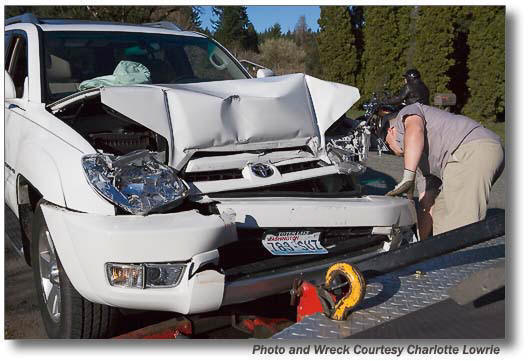The Ultimate Camera Crash Test
By Charlotte K. Lowrie
There are photographers who are “hard on gear.” I
only recently qualified for that category--a completely
unintentional, and certainly dubious distinction.
It was a beautiful spring-like Saturday as I drove to a shooting
assignment. As usual, sitting in the passenger seat of my new
SUV was my miniature Schnauzer--my constant companion. And
sitting in front floorboard, in an open picnic case, was my
Canon EOS 1Ds Mark II and two lenses (a Canon EF 24-70mm f/2.8L
lens and an EF 70-200mm f/2.8L IS). The picnic case was hardly
standard photographic gear. It was, instead, a home-grown idea
for keeping the cameras and lenses stationary while driving, but
still having them within arm's reach for easy access.

The Crash
I noticed that a small pickup outfitted with an obviously homemade steel pickup bed was ahead of me. We were driving slowing when something along the side of the road caught my eye. I glanced off the road for a second to see what it was. When I looked back to the road, I saw that the truck in front of me had come to a complete stop. In the instant that I slammed on the brakes, I calculated that I had about a quarter car-length’s stopping distance. I hoped against hope that I could stop before hitting the truck. Hope, however, wasn’t enough, and the impact was tremendous.
I came to with an airbag in my face. I looked over to see my dog cowering underneath the passenger-seat airbag. I called her, and she responded immediately. When the smoke from deflating airbags cleared, I saw that the hood of my car was crumpled up to the windshield. Within minutes, passersby helped me pry open my door and, thankfully, I saw that the other driver, like me and my dog, was shaken but unhurt. We looked over his vehicle thoroughly and it showed no damage. My SUV, however, was a wreck.
Testing the Camera After the Crash
While the accident reports were being completed, I retrieved the camera from my car. With no padding except a flimsy makeshift case, I knew that the camera and lenses had taken the full impact of a crash—a crash that moved the dashboard forward noticeably.
With the camera in hand, I looked for scratches and dents, but the exterior of the camera and lens showed no signs of damage. I turned the camera on, and the LCD panels lit up. Just as the tow truck driver loaded my smashed SUV on a tow bed, I squeezed off a few shots of my SUV--not expecting that the camera or lens would operate properly.
Sometimes the photography gods smile on photographers, and this was one of those days. The camera and the 24-70mm lens appeared to operate normally.
When I got home, I processed the images on the computer. Only then could I be sure that the camera and at least one of the lenses survived the impact in good working order. The pictures showed no signs of damage to the camera or lens. The next day, I tested the 70-200mm lens, and pictures from it were as sharp as images taken before the wreck.
On Reflection
These days, my Schnauzer rides in the back seat in a kennel. My Canon gear rides in padded camera bags--secured in the front passenger seat with a seatbelt. And I’m considering writing a letter to the manufacturer of my car to suggest that they adopt the same crash-proof design for their vehicles that Canon uses for its cameras and lenses.
(c)
Charlotte Lowrie--All rights reserved. May not be copied or
reprinted without permission.
|
FastCounter by MSN bCentral |
All images and articles are Copyrighted (c) 2005 WordsandPhotos.org |
